In a world where self-reliance and preparedness are necessities and not just virtues, equipping yourself with the right tools can make all the difference in survival situations. Whether you find yourself in the dense wilderness, facing the unpredictability of nature, or simply aiming to bolster your self-defense and hunting capabilities, selecting the best survival air rifle is a critical decision.
Key Takeaways:
- The top survival air rifles are powerful, precise, and durable, making them perfect for hunting and protecting yourself in the wild.
- Top brands include Umarex, Benjamin, RWS, and Ruger, each offering models with unique features suited for survival scenarios.
- Air rifles can shoot at different speeds, depending on how they’re made, the kind of pellet they use, and their power.
- It’s important to understand the laws about air rifles in your area and always handle them safely. Proper use and storage are key to preventing accidents.
This article closely examines the best survival air rifles, offering insights and expert recommendations on the top models that blend power, precision, and durability. From the stealthy hunter to the backyard marksman, explore a range of air rifles designed to meet various survival needs.
Understanding Air Rifles
Air rifles, unlike regular guns, use stored compressed air or CO2 to shoot pellets or BBs. This method offers a good mix of strength and accuracy but is quieter, making these rifles great for hunting small animals or target practice alone.
The materials used to make air rifles greatly affect how well and long they work. Different materials have various advantages, including making the rifles lighter, more durable, rust-resistant, and better looking.
Here’s an overview of the most commonly used materials in survival air rifles:

Types of Air Rifles and Their Uses
The type of air rifle suitable for you depends on your specific needs and preferences. Here’s a summary of the most common types of air rifles and their uses:
Spring-Piston Air Rifles
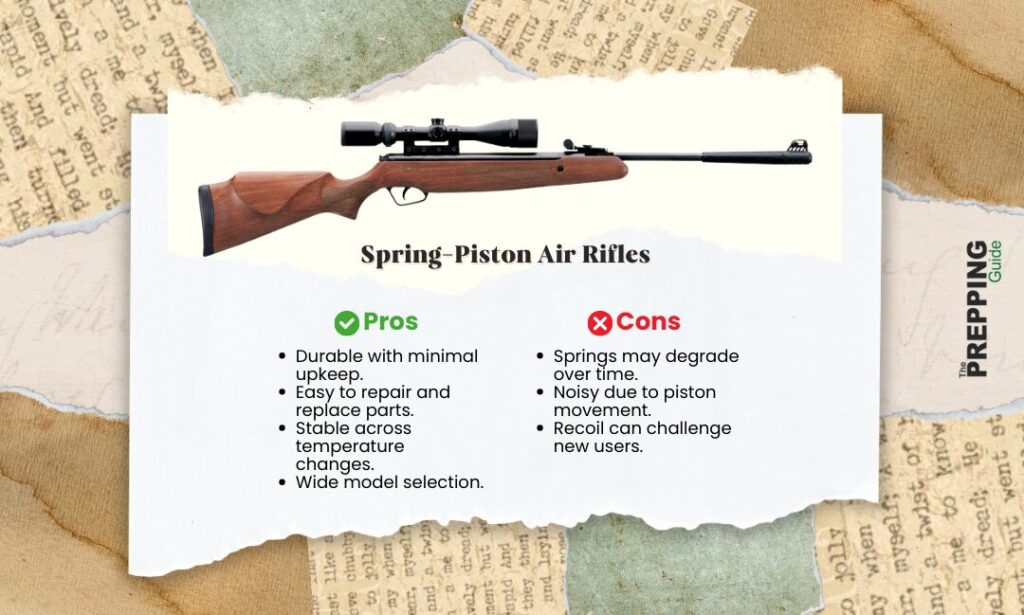
Spring-piston air rifles use a spring-loaded mechanism to compress air, which propels the pellet out of the barrel. They are popular for their simplicity and durability, requiring no external power source like CO2 cartridges. This type of air rifle is typically manually cocked by breaking the barrel or pulling back a lever, making them straightforward and reliable for various shooting activities.
CO2-Powered Air Rifles
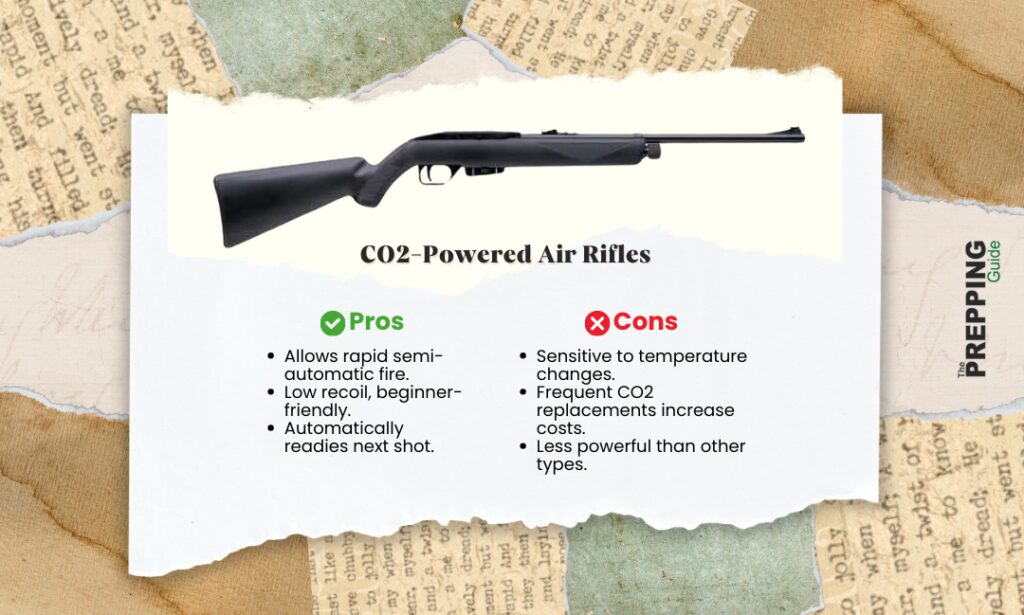
CO2-powered air rifles use carbon dioxide cartridges to propel pellets. These rifles offer semi-automatic firing, allowing for rapid shots without the need to manually cock the gun between each one. Ideal for beginners and those engaging in recreational target shooting, they provide ease of use and consistent firing without the physical strain of manual cocking.
However, they are sensitive to temperature fluctuations and require frequent replacement of CO2 cartridges, which can add to the ongoing costs. CO2 air rifles are versatile and suitable for a range of activities, including target shooting and small game hunting.
Pneumatic Air Rifles

Pneumatic air rifles, also known as pump-up air rifles, utilize compressed air to propel pellets. These rifles can be either single-stroke or multi-stroke (also known as variable pump). They are a good choice for young shooters and beginners, as they allow control over power and effort, suitable for learning how to handle air rifles in activities like target practice and plinking.
For single-stroke models, one pump of air is required for each shot, while multi-stroke models allow the shooter to pump the rifle multiple times to build up more pressure for a more powerful shot.
Pneumatic air rifles are appreciated for their quiet operation and independence from external power sources like CO2 cartridges. They offer versatility and control over power output, making them suitable for a variety of shooting activities, from backyard plinking to more precise target shooting. However, they do require physical effort to pump, and the consistency of shots can depend on the pumping effort.
Pre-Charged Pneumatic (PCP) Air Rifles
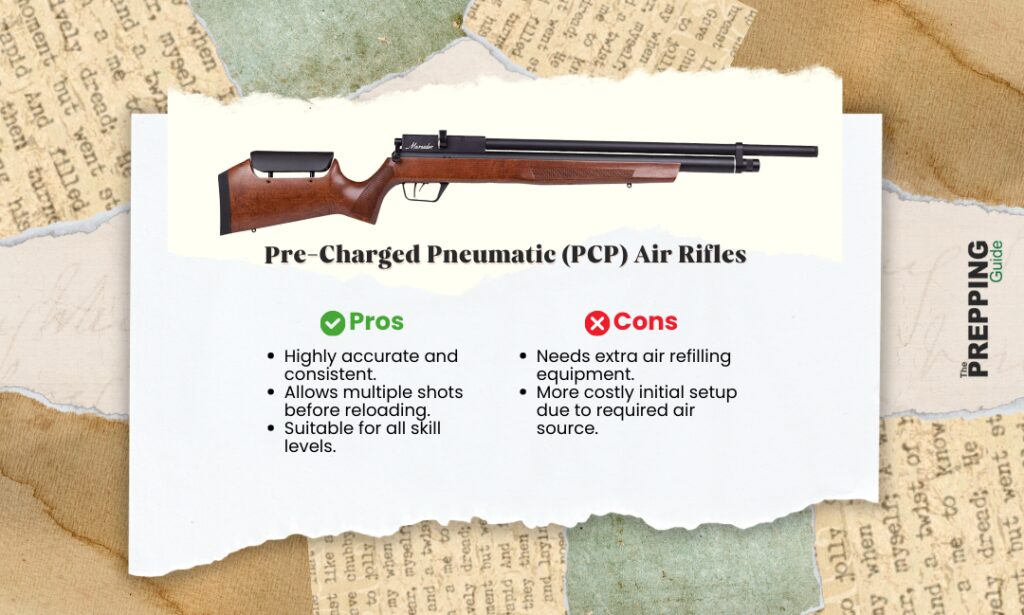
Pre-Charged Pneumatic (PCP) air rifles are powered by compressed air stored in a built-in reservoir. These rifles are filled using a hand pump, an air tank, or a compressor.
Once charged, PCP air rifles can fire multiple shots in quick succession without the need for re-pumping between shots, offering a consistent and powerful performance. They are known for their high accuracy, reduced recoil, and quiet operation, making them ideal for serious target shooters and hunters.
Although they provide a smoother shooting experience, PCP air rifles typically require a larger initial investment due to the need for additional air-charging equipment and are generally more expensive than other types of air rifles.
Gas-Ram Air Rifles
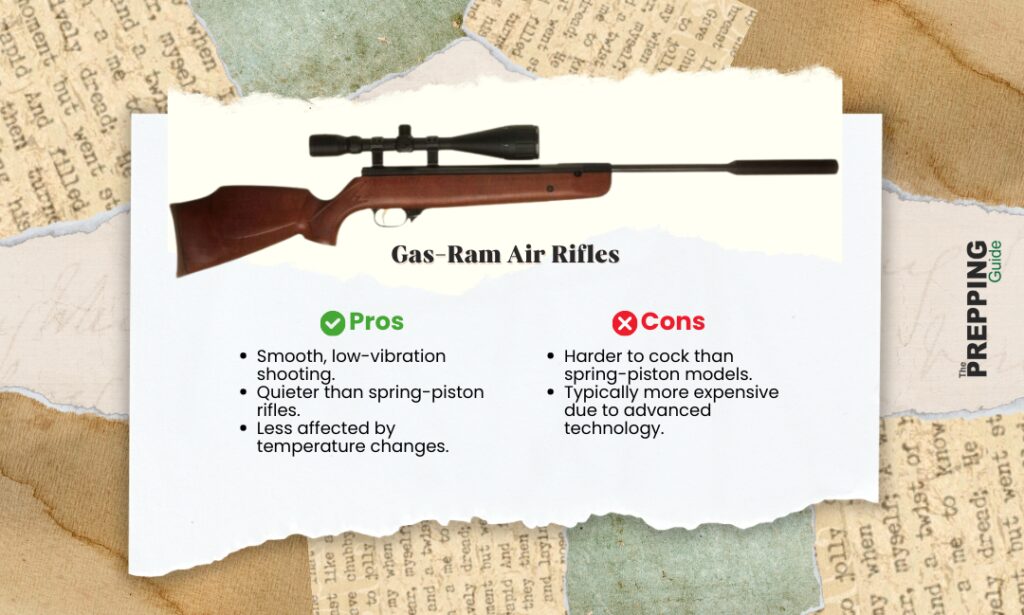
Gas-ram air rifles use a gas-filled piston in place of the traditional metal spring to propel pellets. When the rifle is cocked, the gas in a sealed cylinder is compressed. Once the trigger is pulled, the gas expands to drive the piston forward, pushing air into the barrel to propel the pellet.
Recommended for experienced shooters, gas-ram rifles offer several advantages over traditional spring-piston air rifles: they are typically quieter, have less recoil, and provide a smoother shooting experience. Additionally, they tend to be more durable and less prone to wear over time, as the gas piston system doesn’t degrade in the same way metal springs can. These rifles are suitable for a variety of shooting activities, from casual backyard plinking to more precise target shooting and hunting.
Break Barrel Air Rifles
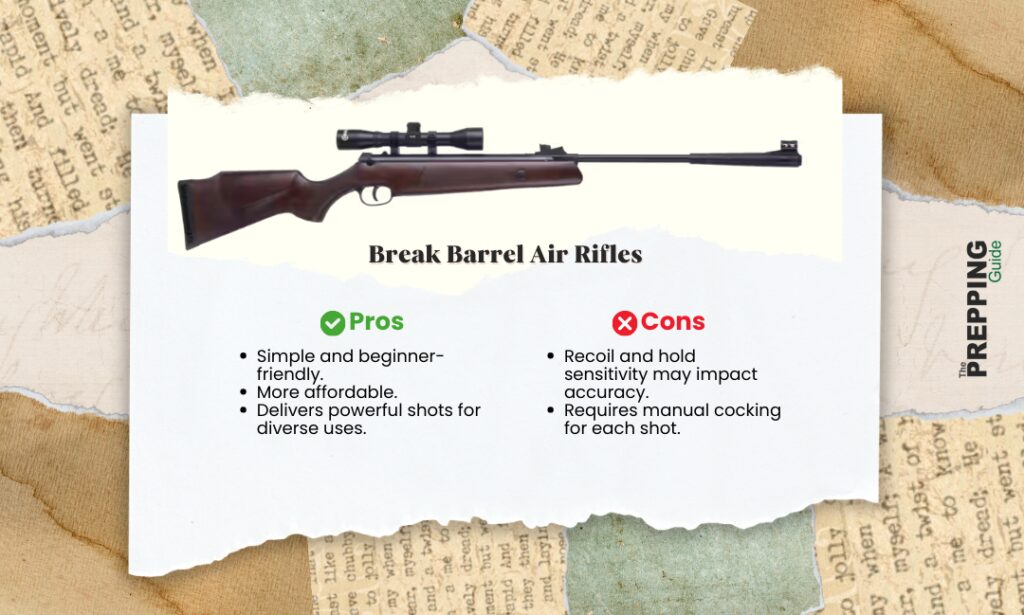
Break barrel air rifles are a type of spring-piston gun where the rifle’s barrel is hinged and can be “broken” at the breech (or back end) to expose the breech, allowing the user to load a pellet directly into it. Cocking the rifle is achieved by pulling the barrel down and back, which compresses a spring or gas piston.
When the trigger is pulled, the compressed mechanism releases, propelling the pellet out of the barrel. Break barrel rifles are popular due to their simplicity and self-contained operation, requiring no external cartridges or charging systems.
They are typically powerful and versatile, suitable for a range of activities from target practice to small game hunting. However, the act of breaking and cocking the barrel can introduce wear over time, and the technique required to do so consistently can affect accuracy for some shooters.
Side Lever and Underlever Air Rifles
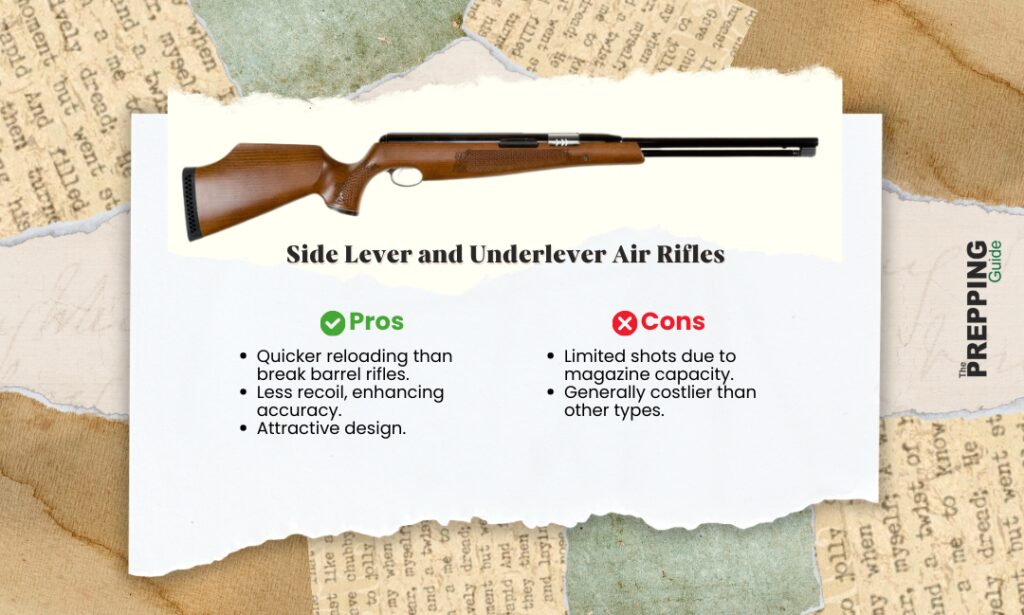
Side lever and underlever air rifles are types of spring-piston or gas-ram air guns that feature a lever to cock the rifle, which is separate from the barrel. These rifles are excellent for competitive shooters and those focused on precision shooting, as they maintain barrel integrity and alignment, leading to better accuracy.
Side lever air rifles: These rifles have a lever located to the side of the gun that the shooter pulls to cock the mechanism. This design often allows for easier and smoother cocking with less impact on accuracy compared to break barrel rifles.
Underlever air rifles: These rifles have a lever located beneath the barrel. The underlever is fixed at the front of the rifle and swings down and back to cock the rifle. This design helps maintain barrel integrity and alignment because the barrel itself does not move during the cocking process, leading to improved accuracy.
Both types are popular among target shooters and hunters who appreciate the consistent performance and reduced barrel wear these designs offer. They are particularly favored for their stability and accuracy, making them excellent choices for competitive shooting and precise targeting.
The 12 Best Survival Air Rifles
| Model | Specifications | Best Feature |
| Umarex Targis Hunter |
|
Versatile for hunting and security needs |
| Benjamin Marauder PCP |
|
High accuracy and power; adaptable for left-handed shooters |
| RWS Model 34 |
|
Suitable for small game hunting and target practice |
| Ruger Blackhawk Scope Combo |
|
Excellent power and lightweight design |
| Ruger Air Hawk |
|
Accurate aiming for both left and right-handed shooters |
| Hammerli AR20 Pro, Silver |
|
Competitive pricing with personalized shooting experience |
| Gamo Whisper Silent Cat |
|
Ideal for hunting small game |
| Gamo Varmint Air Rifle |
|
Effective for pest control and small game hunting |
| CROSMAN 760 Pumpmaster |
|
Versatile for teaching and practice |
| Crossman Vantage |
|
Versatile for teaching and practice |
| Umarex Hammer |
|
Capable of taking large game with innovative features |
| AirForce Texan SS, Hawke Scope Combo |
|
Suitable for hunting medium to large game |
There’s a good range of options suited to various needs when searching for the best survival air rifles, from hunting small game to backyard target practice. Here are some standout models, each with its unique features:
1. Umarex Targis Hunter
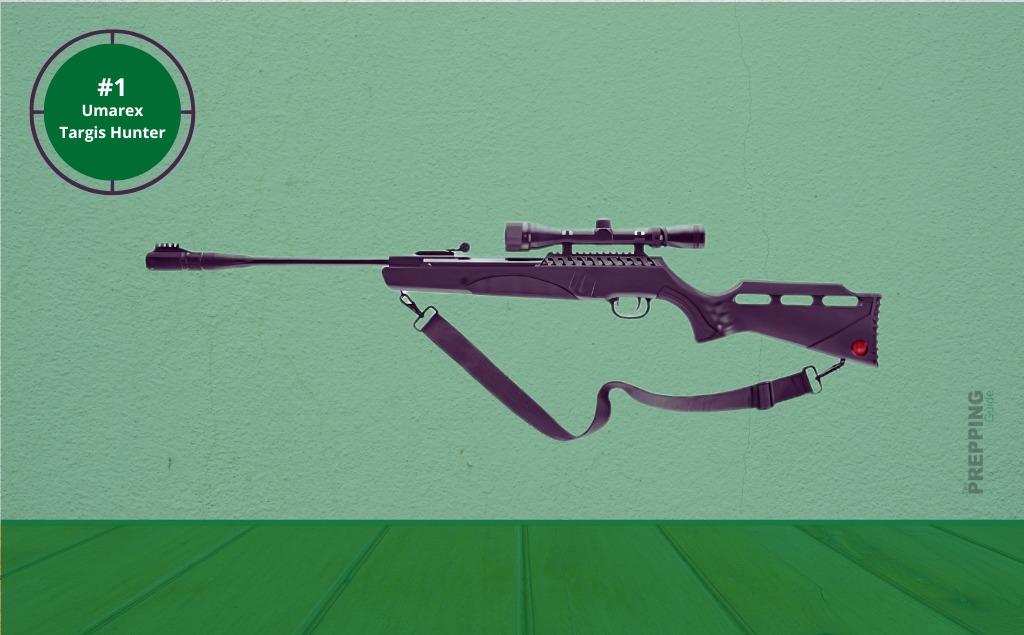
The Umarex air rifle stands out with its simple break-barrel cocking system, making it more accessible for those who find cocking other rifles challenging. It includes an adjustable (Picatinny) 3-9×32 scope for better targeting and features an all-weather stock suitable for various shooting conditions. The 2-stage trigger improves shot accuracy and control, making it a versatile choice for beginners and seasoned shooters.
Pros:
- All-weather stock for durability in various conditions
- Air noise dampening system for quieter operation
- High power for effective shooting
Cons:
- The barrel may warp over time, affecting long-term use and accuracy
2. Benjamin Marauder PCP Air Rifle, Synthetic Stock
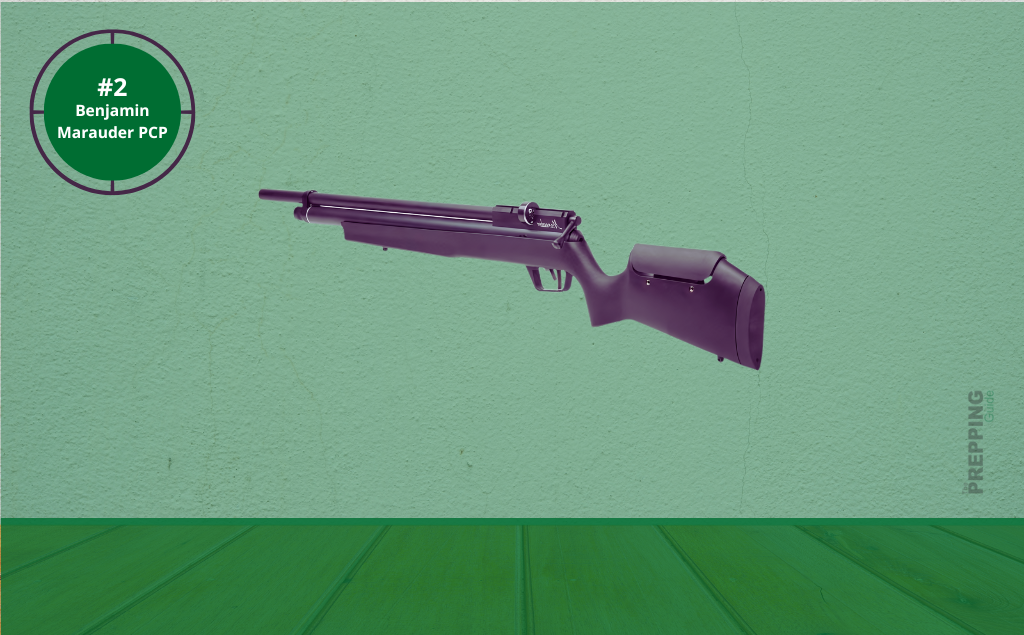
This Benjamin Marauder air rifle is a PCP model known for its accuracy and high power with minimal recoil. It features a durable synthetic stock, raised aluminum breech, and metal trigger for enhanced durability and performance. The rifle is customizable for air refill methods, and the bolt can be reversed for left-handed shooters, making it adaptable to user preferences.
Pros:
- Upgraded valve for improved shooting performance
- Gagged barrel ensures unrivaled precision
- The bolt can be reversed for left-handed shooters, adding to its versatility
Cons:
- Weight may be cumbersome for some users
3. RWS Model 34 .22 Caliber Pellet Air Rifle
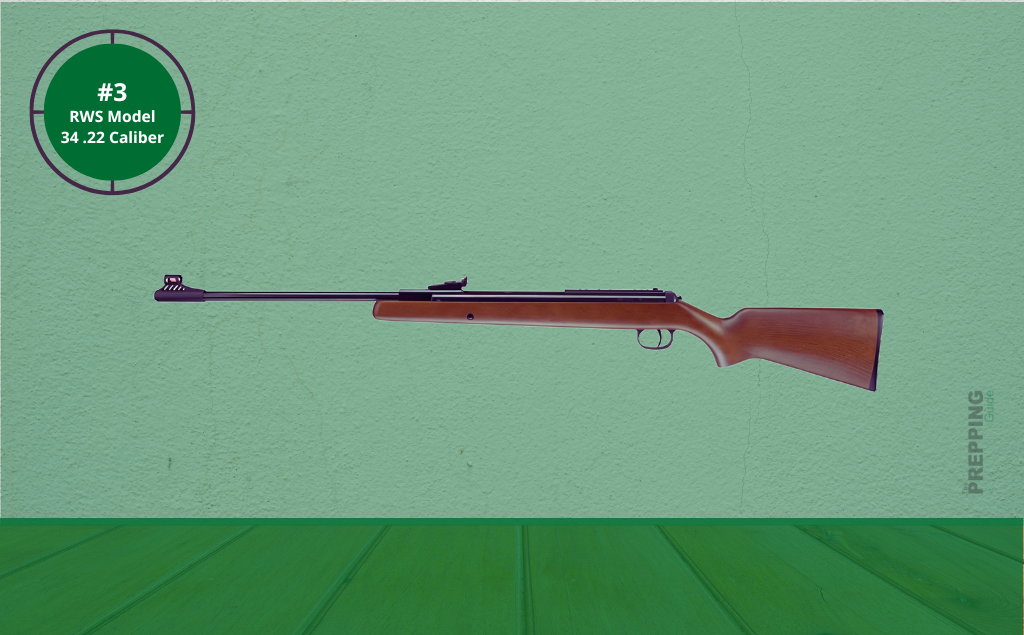
Manufactured in Germany, the RWS Model 34 air rifle features a classic hardwood stock design with an ambidextrous grip, making it suitable for all shooters. Its easy break-barrel cocking system, two-stage trigger, and adjustable scope make it an excellent choice for small-game hunting and target practice. The rifle’s craftsmanship ensures durability and a great shooting experience.
Pros:
- Superior craftsmanship and durable design
- Easy to check safety features
- Comfortable shoulder feel and quiet operation
Cons:
- Wood stock may feel thin to some users
4. Ruger Blackhawk Scope Combo
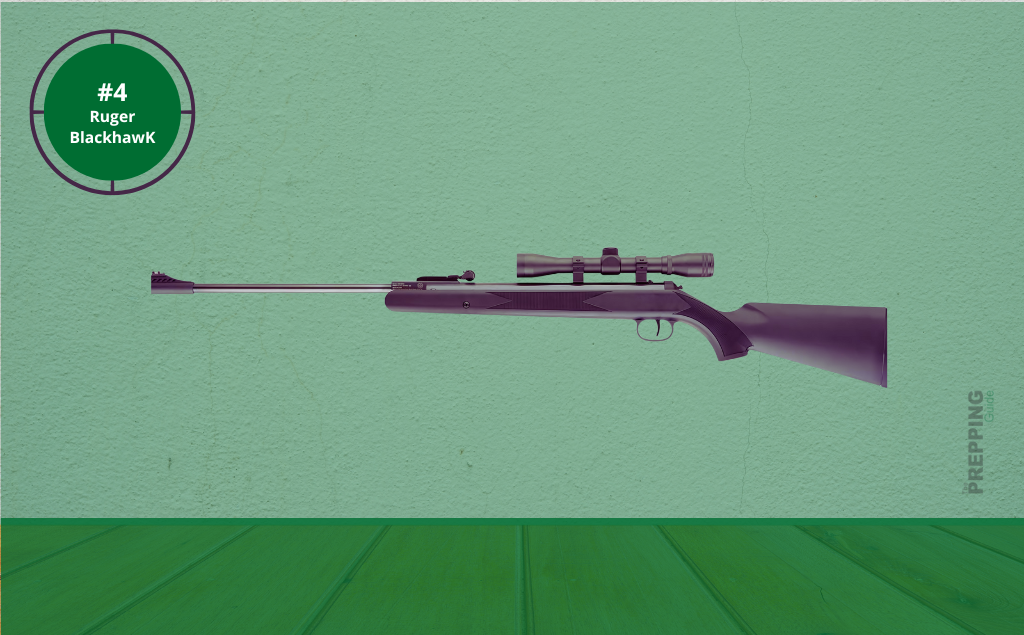
The Ruger Blackhawk .177 caliber air rifle is known for its impressive spring-piston mechanism, delivering a velocity of 1000 fps. It features an all-weather polymer black stock with checkered grip areas for better handling, a blued metal finish for durability, and a solid rubber pad to absorb recoil. Its break-barrel system is notably easy and smooth, enhancing safety with each use.
Pros:
- Excellent power and lightweight design
- Requires little to no maintenance, making it user-friendly
- Offers a solid and comfortable grip
Cons:
- Dovetail scope rail might limit optical customization options
5. Ruger Air Hawk
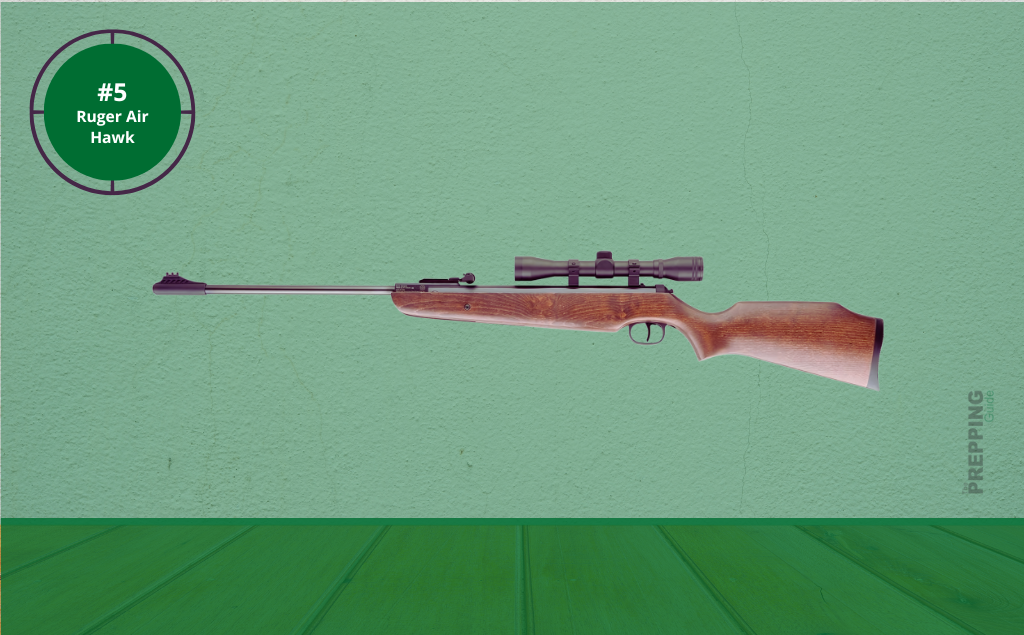
This .177 caliber Ruger Air Hawk rifle features a single-shot cocking mechanism, enhancing control over ammunition. It’s renowned for its accuracy and boasts a sleek hardwood stock that’s comfortable for both left and right-handed shooters. The rifle comes equipped with a 4×32 airgun scope to withstand the double recoil action typical of air rifles.
Pros:
- Excellent fiber optic sight for improved aiming
- An affordable price point makes it accessible to many shooters
- Sturdy and solid stock for durability
Cons:
- Weight may be challenging for younger or less experienced shooters
6. Hammerli AR20 Pro, Silver
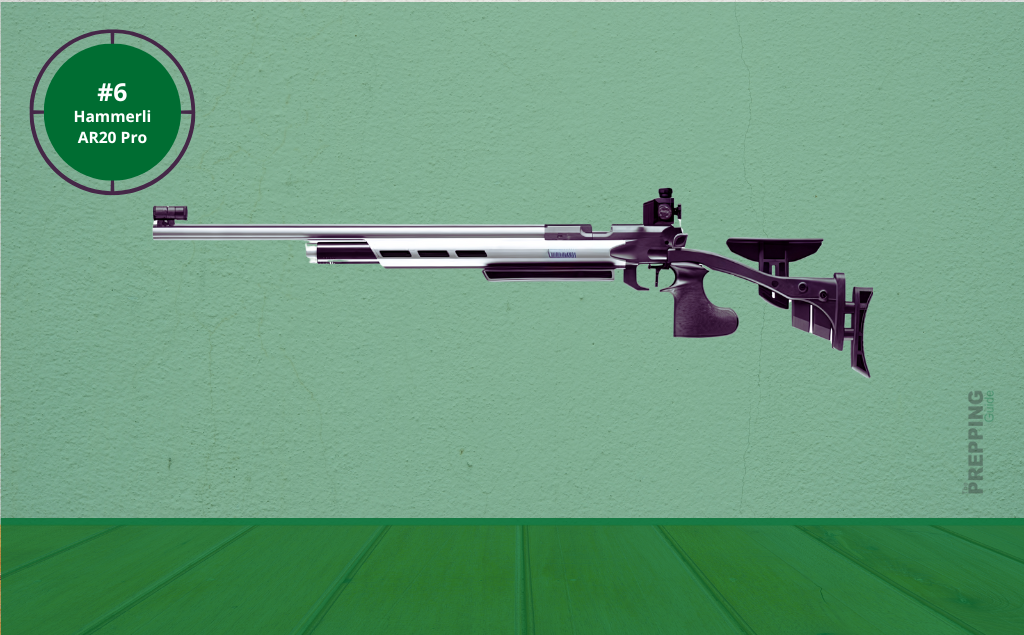
The Hammerli AR20 Pro features a sophisticated design with an adjustable stock, making it suitable for shooters of all sizes. It comes with a 300 bar compressed air system and a Lothar Walther match barrel for precision. Its wide loading recess and precision feed enhance usability, while the ambidextrous cocking piece with release button adds to its versatility.
Pros:
- Competitively priced for its feature set
- Includes ambidextrous receiver and stock
- Adjustable match trigger for personalized shooting experience
Cons:
- May not meet the needs of serious competition shooters due to certain limitations
7. Gamo Whisper Silent Cat
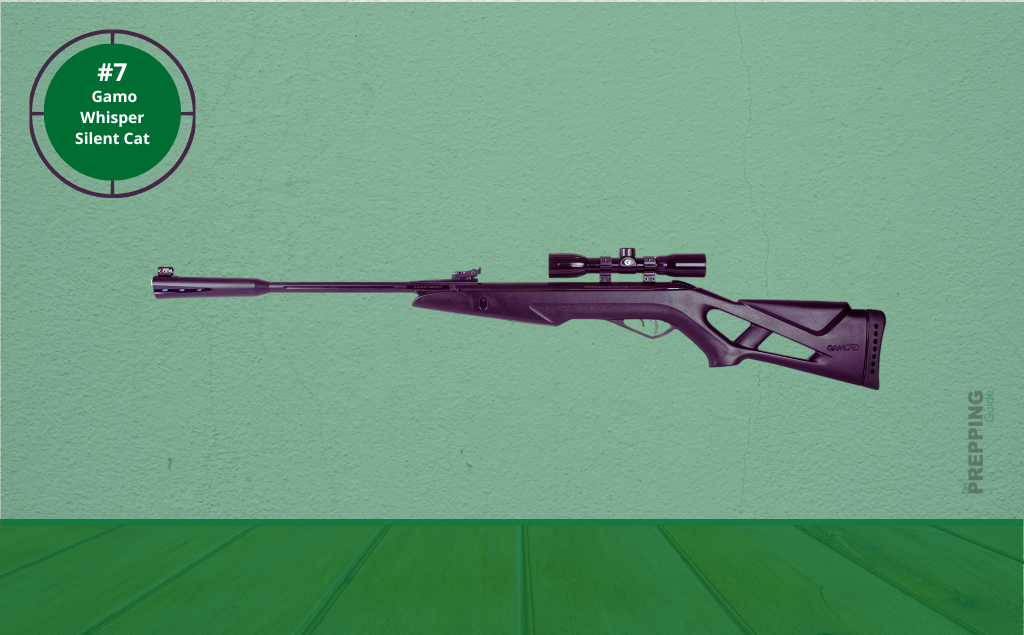
The Gamo Whisper Silent Cat air rifle is distinguished by its lightweight design and powerful 1200 fps velocity, making it ideal for small game hunting. It features a light break-barrel system for easy cocking and is known for its quiet operation, minimizing noise during shooting sessions.
Pros:
- Highly accurate and powerful for effective shooting.
- Lightweight design enhances portability and ease of use.
- Powerful performance ideal for hunting small game.
Cons:
- Ttrigger may require a harder pull, which could affect shot precision
8. Gamo Varmint Air Rifle
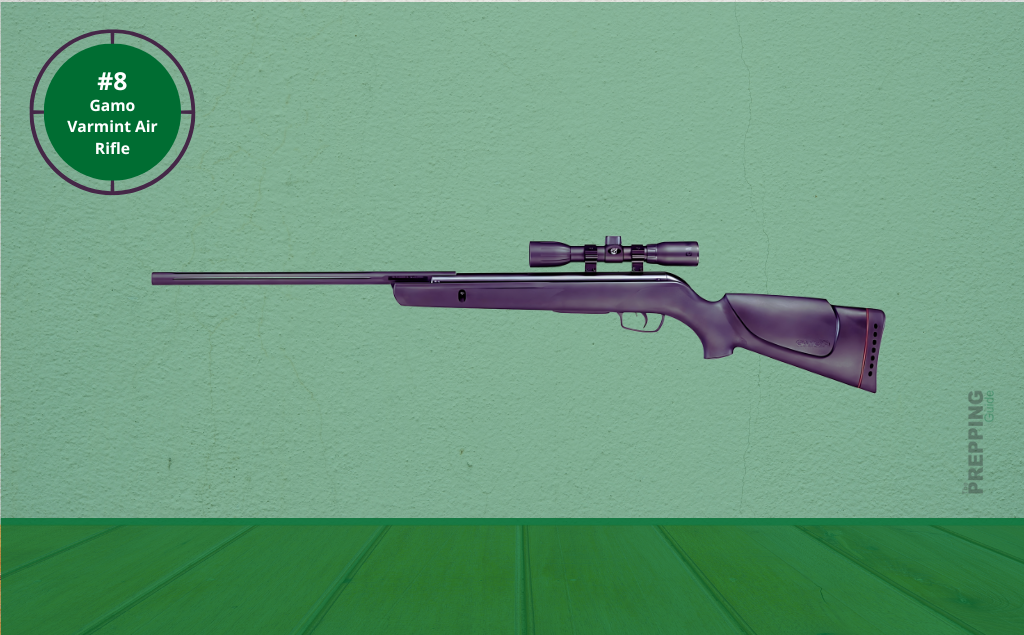
The Gamo Varmint Air Rifle is a highly popular model known for its accuracy, lightweight design, and impressive power, typically shooting at 1250 fps with PBA pellets. It’s designed for pest control and small game hunting, featuring a synthetic stock that withstands various weather conditions, and a 4×32 scope to improve aim and accuracy.
Pros:
- High velocity for effective pest control
- Durable and weather-resistant design
- Includes scope for improved accuracy
Cons:
- May be too powerful for beginners
- Scope quality could vary
9. CROSMAN 760 Pumpmaster
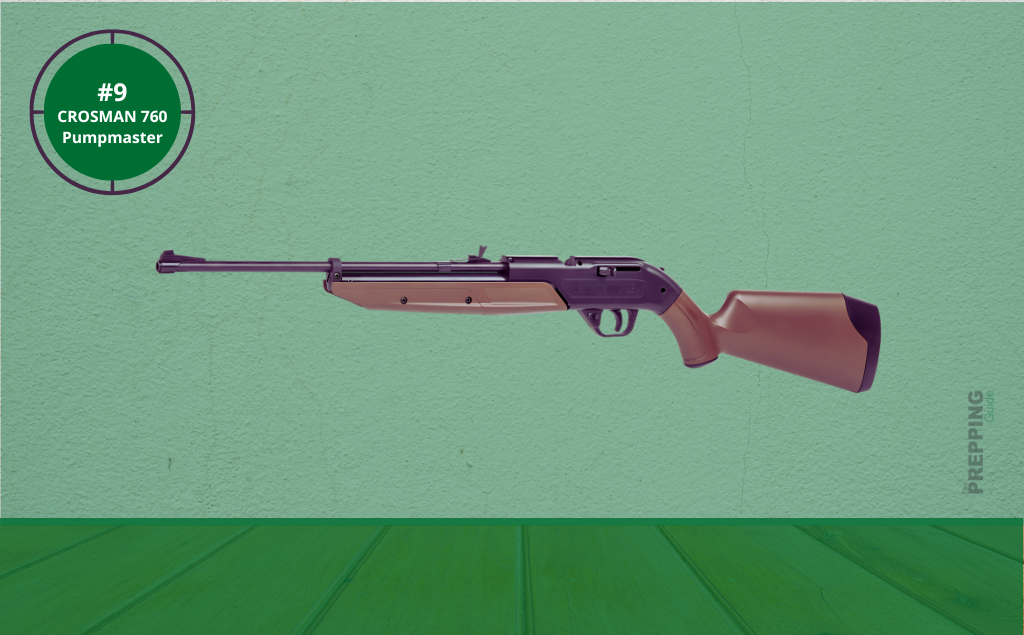
This entry-level air rifle is famous for its versatility, shooting both BBs and pellets. The CROSMAN 760 Pumpmaster is a multi-pump pneumatic rifle, ideal for teaching the basics of shooting and for practice due to its low velocity and adjustable power based on the number of pumps.
Pros:
- Versatile, shoots both BBs and pellets
- Adjustable power for safe learning
- Lightweight and easy to use for beginners
Cons:
- Lower power compared to more specialized rifles
- Build quality may not suit all preferences
10. Crossman Vantage
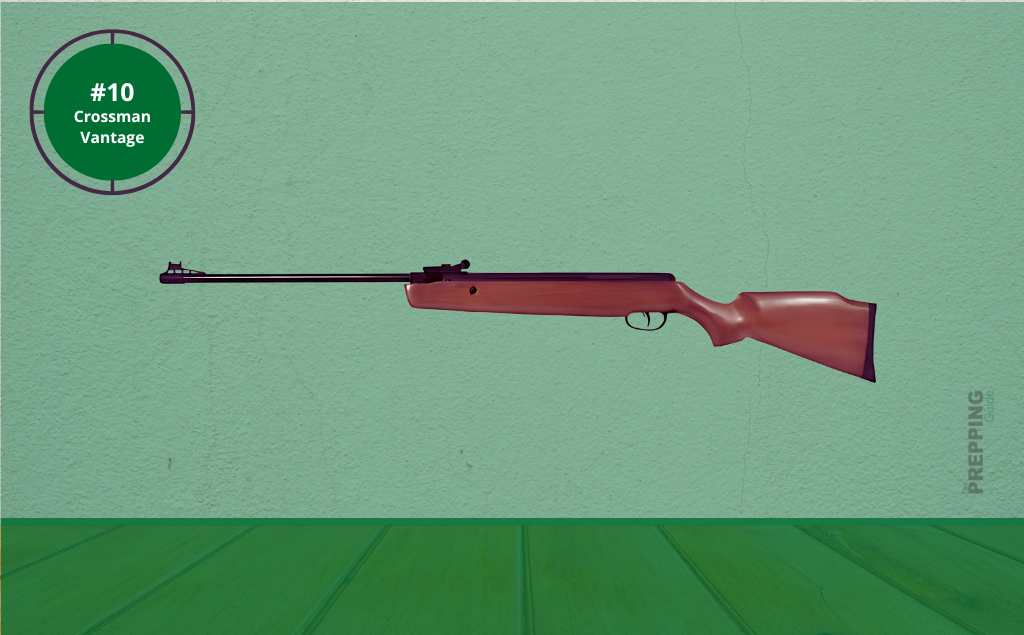
The Crossman Vantage is a spring-powered air rifle that offers reliability and precision at a budget-friendly price point. It features a hardwood stock for a classic feel, a fiber optic front sight for better targeting, and is known for its quiet operation, making it suitable for backyard plinking and small game hunting.
Pros:
- Affordable price point
- Quiet operation suitable for residential areas
- Durable hardwood stock
Cons:
- Spring action may require getting used to
- Limited accessories compared to higher-end models
11. Umarex Hammer
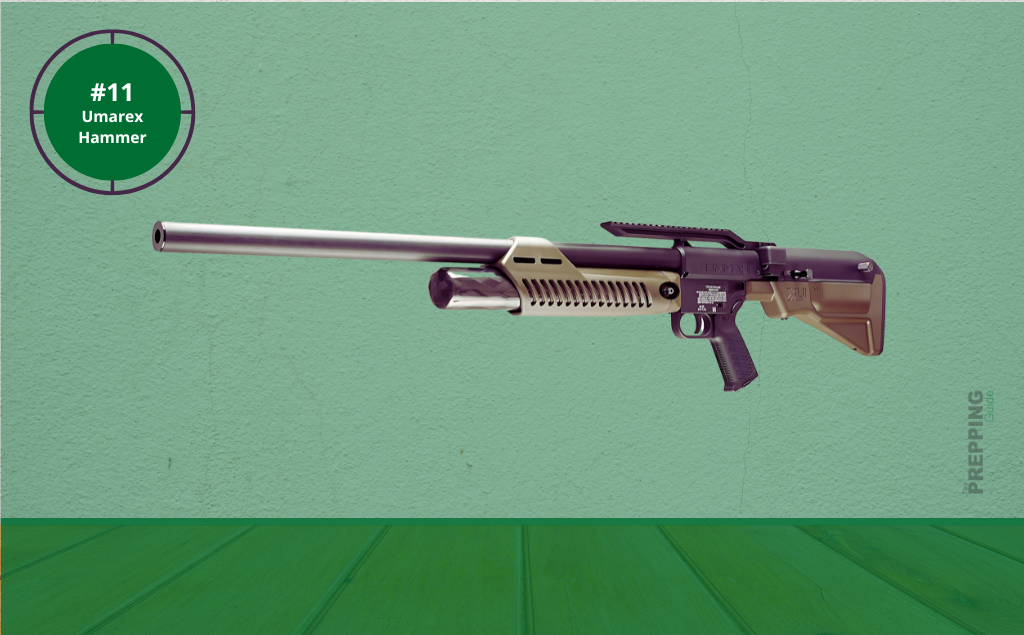
The Umarex Hammer is an American-made PCP air rifle that’s among the most powerful on the market, capable of taking large game with its .50 caliber pellets. It boasts innovative features like a lights-out 700 ft-lbs of energy and a magazine that holds two shots, ready for quick follow-up shots.
Pros:
- Exceptionally high power for big game hunting
- Quick follow-up shots with two-shot magazine
- Robust and durable construction
Cons:
- Higher price point due to advanced features
- Requires specific use cases given its power
12. AirForce Texan SS, Hawke Scope Combo
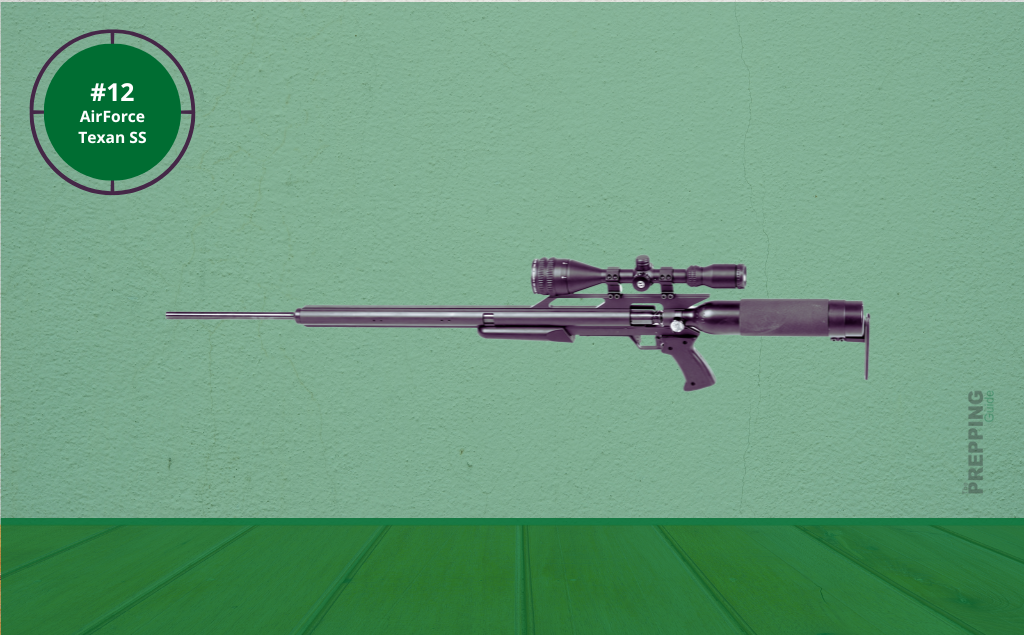
The AirForce Texan SS with a Hawke Scope Combo is renowned for its power and precision, making it a top choice for hunters. The silenced barrel significantly reduces noise, and the included Hawke scope provides crystal-clear optics for long-range targeting. This air rifle is a favorite among enthusiasts for its accuracy and the ability to hunt medium to large game.
Pros:
- Powerful and accurate, suitable for a range of game
- Silenced barrel for quiet operation
- High-quality scope included
Cons:
- Premium price for premium features
- May be overpowered for casual or beginner shooters.
Why Choose an Air Rifle for Survival?
Air rifles, often underestimated, offer distinct benefits that make them an important addition to a survivalist’s equipment.
Low Noise Levels of Air Rifles
One of the key advantages of air rifles in survival situations is their quietness. Unlike traditional firearms that make loud noises with each shot, air rifles are much quieter, allowing for stealthier hunting. This quiet operation helps avoid scaring away other nearby game and is crucial for staying unnoticed in situations where remaining hidden is important for safety.
Economical and Accessible
Another strong reason to choose an air rifle is the affordability and easy availability of its ammunition. Unlike firearm ammunition, which can be expensive and sometimes hard to find, air rifle pellets are inexpensive and readily available. This accessibility allows for frequent practice without significant cost, helping to improve accuracy and ensure readiness when precision is crucial.
User-Friendly
Air rifles are particularly user-friendly and suitable for shooters of all skill levels. They are simple to operate and maintain, needing little technical know-how. This simplicity is a key advantage in survival situations, where adaptability and resourcefulness are crucial. Additionally, the ease of teaching others to use an air rifle safely and effectively is a significant benefit, allowing for the sharing of hunting and protection responsibilities within a group.
Reliability, Accuracy, and Portability
Choosing the right air rifle requires considering its reliability, accuracy, and portability. These factors are crucial in a survival situation, where the rifle must perform reliably under different conditions. Reliability guarantees that the rifle will work when needed, accuracy improves the chances of a successful hunt or defense, and portability makes it easier to move across various terrains.
Key Features to Look for in a Survival Air Rifle
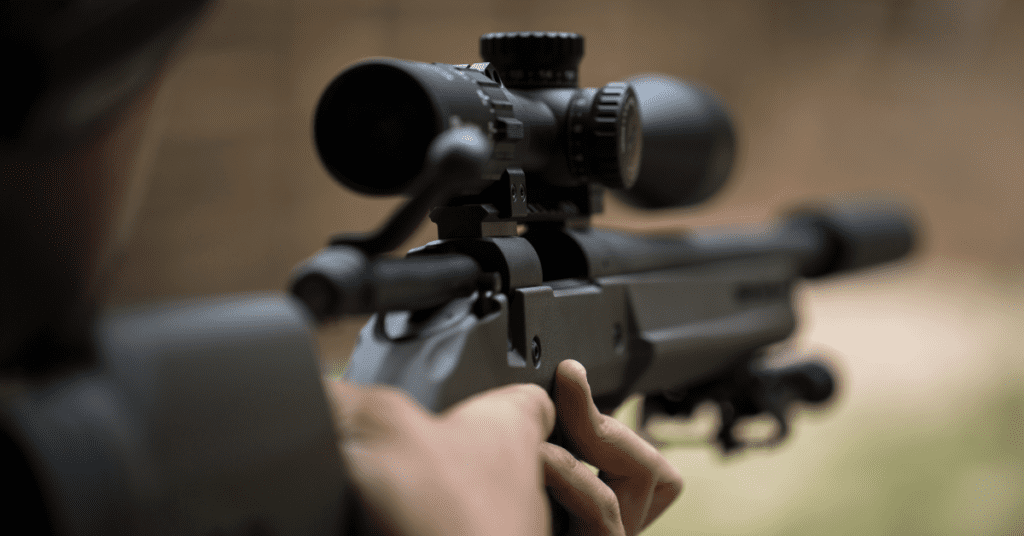
With numerous options available, selecting the best air rifle can be daunting. Understanding the key features that meet survival needs can simplify the decision-making process.
Here are the essential characteristics that make an air rifle not just a tool, but a survival partner.
Matching the Rifle to Your Needs
The first step in choosing a survival air rifle is to decide its main purpose. Will it be used for hunting small game, self-defense, or both? This decision affects the choice of caliber, power, and accuracy. For example, a .22 caliber rifle is versatile enough for both hunting and defense, offering a good balance of range and impact.
Durability and Reliability
Survival situations demand reliability. An air rifle’s construction and materials directly impact its durability and ability to perform under adverse conditions. Rifles with a proven track record of withstanding rugged use and environmental challenges are preferable. Stainless steel components and weather-resistant stocks are indicators of a rifle built to last.
Ease of Upkeep
In survival scenarios, the luxury of professional maintenance is not always available. Therefore, ease of upkeep becomes a critical feature. Air rifles requiring minimal maintenance while retaining peak performance are ideal. Simplicity in design allows for field repairs and adjustments, ensuring the rifle remains operational when it’s needed most.
The Balance of Power and Accuracy
Power and accuracy are crucial for a survival air rifle. The rifle needs enough power for humane kills in hunting and effective deterrence in defense situations. However, this power should not reduce accuracy. Consistently hitting targets, even under stress, is vital. Rifles with adjustable power settings offer flexibility, letting the user customize performance for specific needs.
Budget Considerations
Budget is a key factor in choosing a survival air rifle. It involves finding the best value — a rifle that meets survival needs without being overly expensive. While it’s important to invest in a quality rifle, as it is a crucial survival tool, this doesn’t always mean picking the most expensive option. Balancing cost with features and reliability is essential for making a smart investment.
How Fast Can Air Rifles Shoot?
Air rifles can achieve a wide range of velocities, varying significantly depending on their design, the type of pellet used, and the power source (spring-piston, CO2, PCP, etc.).
Here are some examples highlighting the maximum velocities different air rifles can reach:
- Small-caliber (.177) rifles: This rifle can propel light alloy slugs at speeds ranging from 1,300 to 1,650 feet per second. It achieves these high velocities by using a large amount of air to accelerate each shot. However, reaching such speeds typically reduces the number of shots it can fire.
- Gamo 6110017154 Varmint Air Rifle .177 Cal: This model is among the fastest available, firing .177 PBA Platinum alloy pellets at a speed of 1250 feet per second. It is suitable for hunting small game, target shooting, and controlling pests.
- Larger calibers (.25, .30, .357, .45, .50): Generally achieve lower velocities compared to smaller calibers due to the greater mass of the pellets. For instance:
- Smallbore PCP rifles (.25 or .30 caliber) can reach 900 – 1100 FPS.
- Big bore PCP rifles (.357, .45, .50 caliber) have velocities ranging from 500 – 900 FPS.
- Umarex Hammer .50 Caliber:The Umarex Hammer is a powerful air rifle that uses a special air system to generate over 700 foot-pounds of muzzle energy. Despite its considerable power, it has a slower firing speed because it shoots large, .510 caliber, 550-grain lead slugs..
These examples show that while smaller caliber air rifles can achieve higher velocities, larger calibers focus on delivering more kinetic energy, making them suitable for bigger game hunting despite their lower FPS.
How to Maintain Your Survival Air Rifle
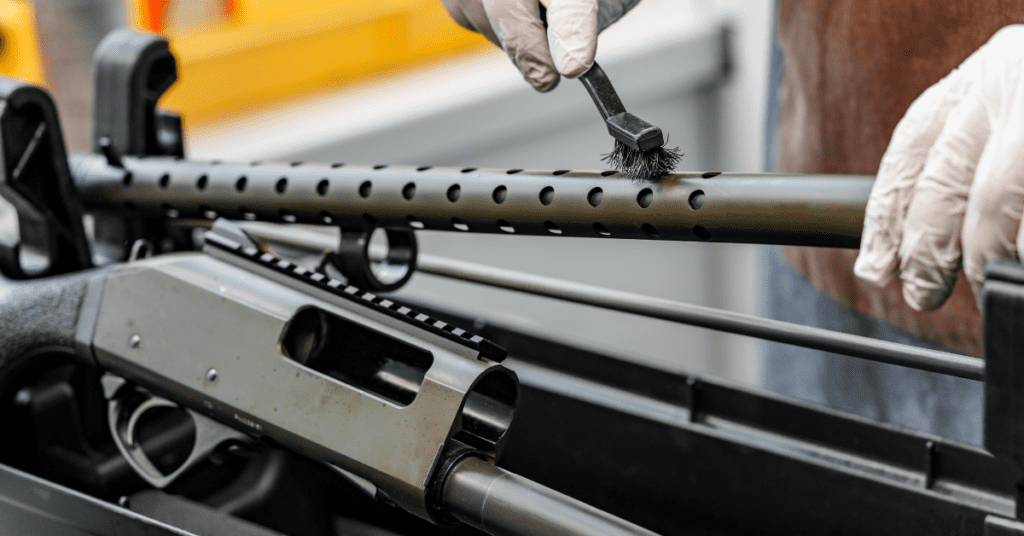
Maintenance is a crucial aspect of ensuring the longevity and reliability of a survival air rifle. A well-maintained rifle is a reliable companion in the wilderness, ready to perform when needed most. This section will offer practical advice on keeping your air rifle in top condition.
Regular Cleaning and Inspection
The foundation of air rifle maintenance is regular cleaning and inspection. Dirt, debris, and moisture are the enemies of any firearm, including air rifles. Routine cleaning after use prevents buildup that can affect performance and reliability. Inspection of all parts, especially seals and moving components, helps identify wear or damage early, preventing potential failure in critical moments.
The Importance of Proper Storage
Storage conditions significantly impact an air rifle’s lifespan. Keeping the rifle in a dry, cool place minimizes the risk of rust and corrosion. Utilizing gun safes or cabinets that control humidity levels further protects the air rifle from environmental factors that could degrade its materials and components over time.
Handling and Transport Care
Proper handling and transport are essential to maintaining an air rifle’s condition. Using protective cases during transport protects the rifle from bumps and scratches, while careful handling prevents accidental drops or impacts that could misalign sights or damage mechanisms. Awareness and respect for the rifle extend its life and ensure it remains a dependable tool.
Periodic Professional Servicing
While routine maintenance can be performed by the user, periodic professional servicing ensures that deeper mechanical aspects of the air rifle are in optimal condition. Professionals can perform detailed inspections, replace worn parts, and make adjustments that enhance the rifle’s performance. Establishing a regular servicing schedule contributes to the air rifle’s longevity and reliability.
DIY Maintenance Skills
Developing do-it-yourself (DIY) maintenance skills empowers the survivalist to address minor repairs and adjustments independently. Resources such as manuals, online tutorials, and workshops provide valuable knowledge and skills. Self-sufficiency in maintenance ensures the air rifle can be kept in working order, even when professional services are not accessible.
Air Rifle Accessories for Survival
The right accessories can transform a basic air rifle into a versatile tool for survival. Let’s take a look at recommended scopes, suppressors, and other add-ons that can improve performance and reliability, as well as customization tips to suit specific survival needs.
Scopes
A quality scope is a crucial accessory for an air rifle, especially when accuracy is key in survival situations. Scopes help with magnification, allowing for precise targeting at longer distances. When choosing a scope, consider the reticle type, magnification range, and durability to match your needs. A good scope improves accuracy and increases the rifle’s effective range.
Suppressors
Suppressors, when legal, provide important advantages for survival air rifles. They reduce the noise of shots, allowing for quieter hunting and helping to avoid detection. This silence is crucial for preserving game in an area and staying stealthy when needed.
Also, research shows that “noise exposure from firing air rifles can pose auditory risks, especially to young users.” Using suppressors, and ideally additional hearing protection, can help minimize these auditory risks.
What Ammunition Do You Use for An Air Rifle?
While not a traditional accessory, the choice of ammunition plays a critical role in the performance of an air rifle. High-quality pellets can significantly improve accuracy and consistency, factors that are crucial in survival situations
Air rifle ammunition comes in various types, each designed for specific uses and preferences. Here’s a rundown of the main types and their primary uses:

Best Practices for Safe Handling
There are over 300,000 air gun injuries yearly in the United States alone. Safety is the cornerstone of responsible air rifle usage. Here are foundational safety tips every user should observe:
- Always treat the air rifle as if it is loaded. This mindset encourages caution and respect for the potential harm an air rifle can cause.
- Be mindful of the muzzle direction at all times. Ensuring the air rifle is pointed in a safe direction, especially when loading or unloading, minimizes the risk of accidental discharge.
- Identify the target and what lies beyond it. Awareness of the target’s surroundings is vital to prevent unintended harm to others or damage to property.
- Regular maintenance is non-negotiable. A well-maintained air rifle is less likely to malfunction, reducing the risk of accidents. Cleaning and inspecting the air rifle regularly ensures it remains in safe working condition.
- Use proper storage solutions. Secure storage prevents unauthorized access to the air rifle, particularly by children or individuals unfamiliar with safe handling practices.
- Educate others: Responsible ownership includes teaching your community or household about air rifle safety. Sharing knowledge and best practices promotes a culture of safety and responsibility.
Legal Considerations
Before acquiring an air rifle, it is crucial to familiarize yourself with both local and national regulations. Laws governing air rifle ownership, usage, and transportation can vary significantly from one jurisdiction to another, and ignorance of these laws can lead to serious consequences.
Federal Regulations
At the federal level, air rifles are generally not considered “firearms” under the Gun Control Act of 1968 (GCA), which means they are not subject to the same strict regulations as traditional firearms.
However, some general guidelines still apply:
- Interstate Transportation: Air rifles can generally be transported legally across state lines without the same restrictions as firearms. Nevertheless, owners should verify the laws in both the origin and destination states.
- Sales and Ownership: There are no federal age restrictions for purchasing an air rifle, but many states impose minimum age requirements, typically 18 years.
- Shipping and Mailing: Unlike firearms, air rifles can be legally shipped through the U.S. Postal Service, although other carriers may have their own policies.
State and Local Laws
State and local regulations can differ dramatically. For example:
- Some states require a permit to purchase or own certain types of air rifles.
- Certain cities or counties may have ordinances that restrict the discharge of air rifles within city limits or near occupied buildings.
- Some jurisdictions classify higher-powered air rifles as firearms and regulate them accordingly.
Punishments for Non-Compliance
Violating air rifle laws can result in various penalties, ranging from fines to imprisonment. For instance, unlawfully discharging or openly carrying an air rifle in restricted areas might lead to misdemeanor charges. More severe violations, such as using an air rifle in the commission of a crime, could lead to felony charges.
Hunting Regulations
When using air rifles for hunting, additional guidelines must be followed:
- Species Restrictions: Many states specify which wildlife species can be legally hunted with air rifles. Commonly allowed species include small game such as squirrels and rabbits, but some states also permit hunting larger game with high-powered air rifles.
- Hunting Seasons and Licensing: Hunters must adhere to designated hunting seasons and obtain the appropriate hunting licenses.
- Ethical Hunting Practices: Hunters are encouraged to use air rifles of sufficient power to ensure a humane kill, to avoid unnecessary suffering of the animal.
Ethical Responsibility
Compliance with the law reinforces the importance of ethical responsibility in survival preparedness. Ethical hunters and responsible shooters ensure that their activities do not negatively impact their communities or the environment.
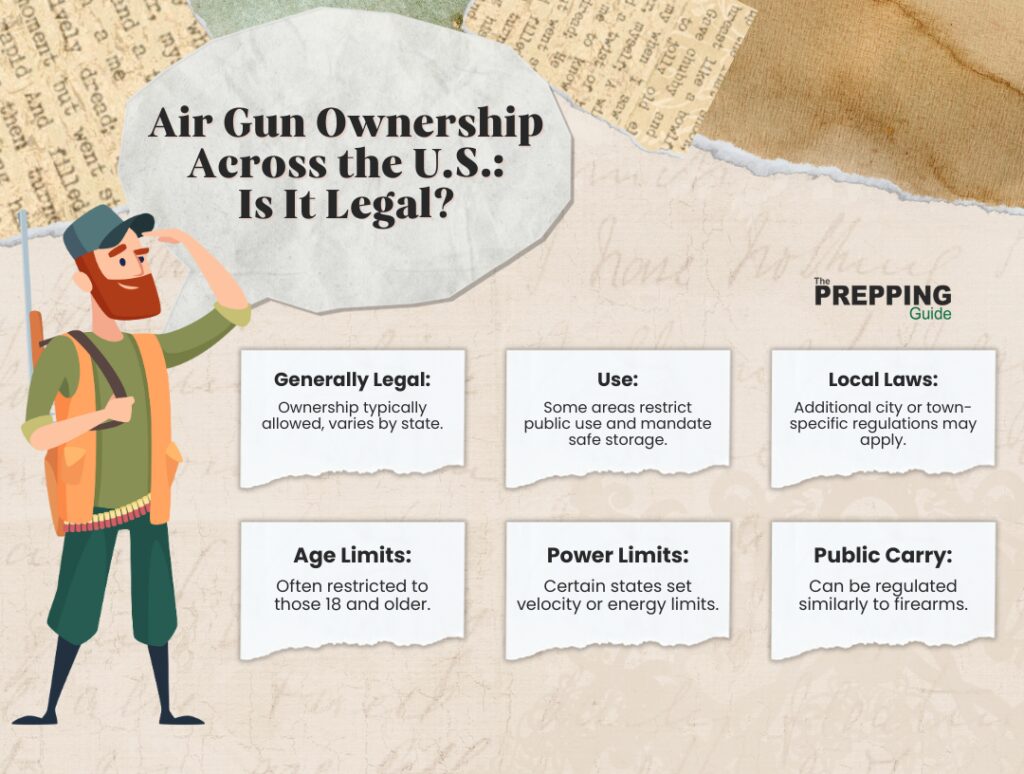
Conclusion
Selecting the right survival air rifle is a vital component of preparedness for anyone looking to enhance their self-reliance in wilderness or security scenarios. The best air rifles for survival are those that combine power, precision, and durability to effectively handle both hunting and defense tasks. It’s crucial to understand and adhere to the legal requirements in your area while practicing safe handling and proper maintenance of your firearm.
Brands like Umarex, Benjamin, RWS, and Ruger offer robust options that cater to a variety of survival needs, making them excellent choices for anyone serious about integrating an air rifle into their survival toolkit.
FAQs
What is the best caliber for a survival air rifle?
The “best” caliber depends on your specific needs and the type of game you intend to hunt. For small game and general target practice, a .177 caliber offers high velocity and a flat trajectory. For larger game or when a more substantial impact is required, a .22 or .25 caliber is preferred due to its greater stopping power. Assess your survival scenarios and choose accordingly.
How often should I maintain my air rifle?
Regular maintenance is key to ensuring your air rifle remains reliable and accurate. Clean and inspect your air rifle after every use, especially if it’s exposed to harsh conditions. A deeper maintenance check, including checking seals and moving parts for wear and tear, should be performed every few months or after prolonged use. Always refer to the manufacturer’s guidelines for specific maintenance schedules.
How powerful can an airgun be?
Airguns can be surprisingly powerful, with some high-end models like the Umarex Hammer .50 caliber achieving muzzle energies exceeding 700 foot-pounds, capable of taking down large game. The power of an airgun typically depends on its design, caliber, and the type of propulsion system used, ranging from CO2 cartridges to pre-charged pneumatic (PCP) systems.

Lewis and Clark took an air rifle with them on their expedition.
Since you wrote that I just looked it up to find out a little bit more on it. They used the same one the Austrian Army used (according to Wikipedia)
Thanks!
While useful for hunting birds or very small game at close range, I would not consider a pellet gun a “security” weapon. A light weight pellet can’t retain much energy at distance. A cute stock and nice sight don’t overcome laws of physics. Picture 6 armed attackers, moving and using cover, assaulting your position from several angles. I think I’ll keep my AR and Shotgun.
Sam you are spot on there.
The weapon has severe limitations. Sadly for those not in the States they don’t have the ability to easily equip the AR so there’s always a consideration for alternatives. When it comes to those six attackers coming at myself and my family, an AR or any normal rifle is going to be a much better approach than an air rifle, that’s for sure.
One exception to that rule might be something like the SMG .22 (assuming you can get in closer range- such as 50 to 60ft- and are using an 1100 psi or better regulator and something like the H&N Hornet ammo). It’s a fully automatic pellet gun that can shoot over 600fps with a higher pressure regulator and can fire 12 pellets a second and has either a 100rd drum or an almost indefinite amount of belts that can be linked together (assuming you have a means of carrying them without getting them caught on something).
It’s in a different class than your standard single shot hunting pellet guns and it had a shorter barrel as it’s considered in SMG territory.
While I probably won’t use an air rifle as a defensive weapon against more than one attacker I would not discard it usage. Unknown to many people there is a vast array of airguns capable of serious damage. There far more calibers than what the autor posted.
This include airguns in .25,.30,.308,.357,.45,.50 and even .72 that is the size of a 12ga shotgun slug!
There are air rifles capable of shoting a .45 cal proyectile at over 1000fps. That compares to being shot with a .45acp pistol. In fact deer and bison have been taken with airguns and also there is full auto airguns available. I think the author should’ve done a little more research about modern airguns.
Thanks for sending that in William.
I did mention that pre-charged pneumatic pump air rifles are capable of automatic fire. The calibers I referred to were only the general calibers of air rifles. Just to avoid any confusion, I have clarified that range.
Cheers for pointing that out.
No problem sir. Keep the good work coming!
Yes could you send me more imf.on the 45cal
There is a great one called the Airforce Texan which is a .45 cal air rifle. It’s a great gun.
There’s a good video of it on youtube here https://www.youtube.com/watch?v=QYoEPHyBmD0
“They’re cheap, dangerous, silent, ridiculously accurate and they are the perfect addition for hunting and security”
Any pellet gun that exceeds 1000 fps muzzle velocity will have the ‘crack’ of supersonic sound. There is nothing quiet or silent about that.
The .177 caliber although faster because they are lighter, not necessarily better because of the noise.
A .22 caliber with a 900 fps muzzle velocity will be quieter and pack more of a punch than a .177 at 1200 fps.
Thanks Joe! Good point with the crack of the sound barrier!
This is great air rifle. Air rifle is very urgent for personal security and also hunting. Thanks for sharing.
I have a Ruger pellet rifle in .177 caliber. It has the suppressor on the barrel. It is still almost as loud as my 10-22.
Sorry, but these are not unregulated in all 50 states. Good ol’ New Jersey considers these to be firearms, just like any other rimfire or centerfire weapon, and require a Firearms I.D. Card. And your info will be recorded in the store’s log book and available for inspection by the police.
I would include the Gamo Maxxim Swarm in the list. At the top for me. It’s a break barrel in .177 or .22 and it uses 10 shot magazines (the only with that feature so far as I know) instead of needing to load one pellet each shot. You still much cock it every shot. The system is very reliable and the rifle is very accurate. I have shot about 2-3 thousands rounds through mine without a failure not caused by me inadvertently double loading.
Although a larger than .30 caliber PCP air pistol would be useable and, certainly better than any type air rifle, for home defense it is only if and when it would be used in a time when the needed replacement parts, accessories and pellets are available to make or keep it functioning, never as the only “SHTF”/prepper weapon one is allowed to own.
If you live in an area where you can’t even effectively defend yourself with a firearm in your home or hunt outdoors due to legislation otherwise… NEWSFLASH! T.S. has already H.T.F. for you and you’re still there by some weird choice! One would have a better chance at viable home defense by working to overturn whatever government’s ban is in place through its legislative repeal or court appeal system than to find a sufficient replacement for a firearm in that of an air powered rifle or pistol when criminals still use firearms to rob you of furniture and/or possibly, your future right to have even a high powered air gun in the home or afield.
Therefore, there is practically NO type air rifle that should be seriously considered as a viable short term solution to self defense or short/long term method of reliable food procurement in the scenarios that preppers prep for; either for practical reasons or to make a political point.
I say the above and now add more below because most PCP air rifles are out of the price range for someone who is raising a family yet they usually require as much equal dollar expenditure, if not more, in accessories to simply either work or to keep working… things such as an manual internal pressure pump, external electric high pressure pump or an external hand pump (all with gaskets & seals of their own that wear out and gun/tank adapter fittings to keep track of) and also any spare air cylinders. Many of these required extras alone would be hard to maintain in storage or in long term use in any prepper scenario that does not include the availability of online parts through the mail or a local parts store that remains open before they are closed by prior-to-need by additional legislation or mob looting!
Springer air rifle springs are prone to breaking in harsh storage conditions, cold weather use and for no reason at all if cheaply made or flawed, gas-pistons must be replaced or topped off with special equipment and gas that is usually nitrogen. All types of air rifles, especially the PCP type, need several to 17 or more rubber gaskets and O-Ring replacements to keep working over time, let alone keep performance specs anywhere near tolerable and most also call for silicone lube or special oils that may be hard to come by in a pinch.
Also, Air-guns that would be useable as defense or game procurement need store bought ammo that can cost more in a lesser caliber than firearm ammo can in a larger caliber (because air-ammo, although without primers or cartridges, is harder to make to the precise tolerances needed for meeting any reliable performance specs (the reliable hunting pellets are not easy & basic lead cast forms to cast and size at home for all but the anal-retentive amongst the pro air shooters), that goes for mostly all types of air-gun ammo in general, even copper BB’s.
If you have to take a 15-20 meter shot or more to defend your home (which is what the non-PCP air rifles are usually deemed effective range for birds, rats and squirrels at up to .25 caliber, opossums at .30 caliber spring or piston) then you don’t need an air rifle, you need a firearm… single shot, semi-auto, auto, muzzleloader, blunderbuss doesn’t matter.. You need a firearm over an air-gun!
As far as an air gun of any size or shape seriously being considered for a long term “SHTF” prepper’s hunting or defensive weapon…. There would be only 1 use in that scenario if it lasted in working condition long enough and that is to be used as a silent distraction or annoyance for anyone beyond 30 yards if using a springer/gas-piston up to.30 caliber or 100 yards for PCP big bore because if a big bore or just a tiny BB goes fast than around 1,000 FPS then it causes a sonic crack and no longer has any purpose that a firearm or, moving where a firearm will be available without legal issues before SHTF, would be worth the investment.
It matters not one bit if you can down a Bison with a .50 cal big bore PCP air rifle at 70 meters… they are not useful for large game or defense beyond that. It does not matter if you can shoot a rock dove with a Hail Mary shot at 1,000 meters with a PCP .22 cal pellet rifle because it is just an annoyance to anything bigger at 20 meters or more (just 15 meters or less if the annoyance is wearing a jacket), let alone 1,000!
If you want long term reliability in a prepping situation or in a firearm restricted area, get a cap lock, non-cartridge pistol revolver, long rifle or shotgun that is not regulated the same as cartridge firearms. If you want added long term reliability in times of sparse resources, get a flintlock muzzle loader in any of the three as well… You are more apt to acquire spare cartridge ammo for regular ammo or to cast your own working round ball and make your own black powder under those circumstances for far less effort and time than find the many parts, O-Rings, pumps, gaskets and supply of special shaped ammo in a true SHTF situation with an air gun being used regularly as a multipurposed prepper weapon no matter how fast or hard it can shoot when times are easier or your life doesn’t depend on it. I can not think of many places, especially in the USA, that ban any caliber old school cap & Ball revolver pistols or Flintlock rifles for protection in the home or for hunting. All of which can be maintained rust free and working with some animal grease and seed oil.
Air rifles for defense or prepping sound good on the surface but, are not worth the investment for any other purpose than using them as a quiet alternative to dispatching small game with non-PCP rifles at less than an ethical 75 yard range or dispatching larger game with a .38 caliber and above PCP air rifle, all of which would need to be used at a time of no urgent need of defense or to be relied upon as a long term food procurement weapon for the above, opening reasons.